We usually make sandwiches to take to our respective work for lunch. Although we have a quite collection of Japanese bento boxes, I rarely make bento for lunch (too much work). This was such a rare occasion. I made this for my wife since she was having surgery for her rotator cuff injury. Although this was a same day surgery, we knew she would be essentially fasting nearly 20 hours, before, during, and after surgery, by the time she was released from the hospital. Knowing she would be hungry I made this bento box so that she could eat it either at the hospital or on the way home in the car. (She wolfed it down in the car on the way home). I chose a two-layered Bento box (for adults) which is very functional and the right size that we like best. Both the bottom of the top layer and lid have gaskets and once the elastic band is applied it makes a good seal preventing leakage.
It came with a Japanese style "Kinchaku" pouch 巾着. Since the rabbit is my wife's Japanese/Chinese zodiac animal, this is very appropriate.
So, the night before, I packed this bento for her. This lunch box comes with a small mold which can be pressed on the rice to make small individual semi-cylinders. This makes eating the rice a bit easier and looks more elegant. I sprinkled dried red perilla salt ("Yukari" ゆかり) on one row and dried green seaweed ("Aonori" 青のり) on the other. The small compartment next to the rice (which can be adjusted) is usually for pickled or salted vegetables ("Tsukemono" 漬物) but I put salad (my cucumber salad, skinned and sliced Campari tomato and arugula).
The upper layer can be divided into 4 compartments for side dishes. The central "H" partition can be slid to adjust the sizes of the end compartments. For protein, I used fish, pork, chicken, and egg including grilled salmon and Spanish mackerel simmered in miso (left), barbecued pork loin thinly sliced (center upper) and chicken squares with gorgonzola cheese and dried fig topped with my home-made figgy cranberry sauce (center, lower). Of course, any Japanese bento box has to have "dahimaki" Japanese omelet (right).
Both grilled salmon and blue fish simmered in miso were leftovers and I separated the two with slices of cucumber.
I added dried green sea weed "Aonori" to the "dashimaki" Japanese omelet . To make a snug fit for the space, I used slices of tomato.
Despite my wife's total lack of ability to use her right arm/hand, she enjoyed and finished the bento box in the car. She said the bento was very good and assured me it was not due to "Hunger being the best sauce". I thought the amount was quite large but she somehow managed to finish it. Now, she is on the mend and gradually regaining her right arm functions with physical therapy. I should make bento more often--for less serious occasions.
Showing posts with label bentou. Show all posts
Showing posts with label bentou. Show all posts
Sunday, January 20, 2019
Tuesday, November 5, 2013
“Eki Ben” 駅弁
When we go to Japan, there are several things we really enjoy (beside going places and seeing our friends and family, of course). The first is visiting Izakaya and tasting all the good food and sake. The second is riding trains (we always get Japan rail passes). The third is eating “bento” 弁当 or more specifically "Eki-Ben" 駅弁 "station bento" boxes while riding trains. We did not do as many bentos as we would have liked but here the ones we tried.
One kind of bento which is rather universal either at the train station or the basement floor of department stores (“Depa-chika” デパ地下) called “Makunouchi Bento” 幕の内弁当 which originated from a bento boxes served at the Kabuki theater between performances. Now, among the bento boxes sold at train stations, makunouchi bento is very common and popular. It is offered at different prices and sizes but, essentially, it consists of many small compartments that include cooked fish, meat, vegetables, and rice.
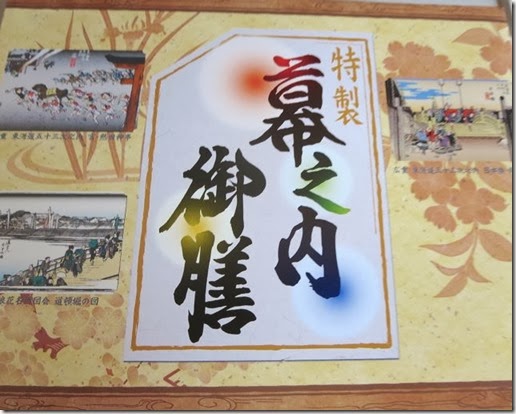
This is the one we had while riding the shikansen 新幹線 train from Tokyo 東京 to Kyoto 京都. This was one of the small makunouchi. The left side is molded rice which is very common in makunouchi which makes picking up rice with chopsticks easy.
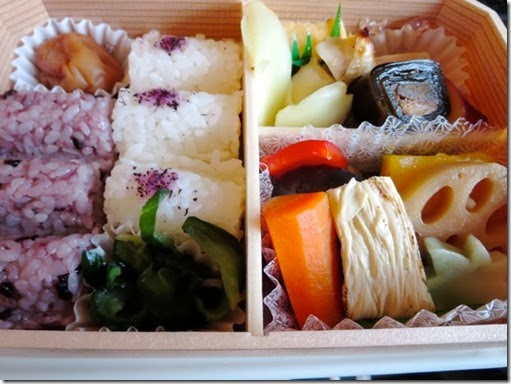
Below is an example of a much larger makunouchi bento which we had when we were riding from Kyoto to Tokyo. There are many more compartments than the previous example and the rice in different preparations was in five of the compartments including Inari いなり寿司 (left middle compartment).
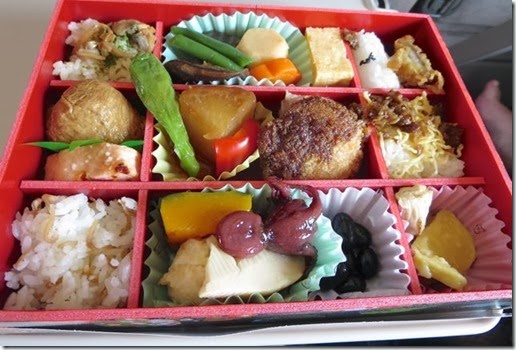
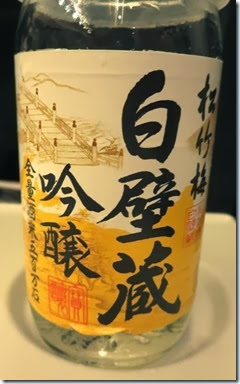 Of course, train riding is thirsty work so some libation goes well with bento. I was a bit disappointed that many kiosks carried different kinds of beer, shochu cocktails, or whisky but sake was either not available or the selection was very limited. Obviously the preference of Japanese people has changed.
Of course, train riding is thirsty work so some libation goes well with bento. I was a bit disappointed that many kiosks carried different kinds of beer, shochu cocktails, or whisky but sake was either not available or the selection was very limited. Obviously the preference of Japanese people has changed.
At a kiosk on the shinkansen platform in Tokyo, however, I found some fairly good sake (left) from Nada 灘 (near Kobe 神戸). We think the ultimate is riding a train in comfortable seats, watching the scenery go by, while tasting so many different food items from the bento box and sipping good sake. (one of the reasons we don’t ride the nozomi, even if we could using our Japan rail pass, is because the scenery flashes by so fast we cant watch it without getting dizzy.) The only problem is that the train rides seem to end too soon.
To fix this problem, we rode a scenic well-appointed tourist train which runs from Akita 秋田 to either Hirosaki 弘前 or Aomori 青森 via a local track called "Gonou-sen" 五能線 along the beautiful coast line facing the Sea of Japan north of Akita called “Resort Shirakami” リゾート白神. While the same trip (between Akita and Hirosaki using Oou line 奥羽本線) can be made by conventional train in 2 hours, this tourist train took over 5 hours from Akita to Hirosaki,
The below was the bento we had during the ride. This came in an imitation “Wappa” わっぱ bento box which, in original form, is made of thin Japanese cedar bent into the shape of a bento box. Of course, this was made of plastic (below right).
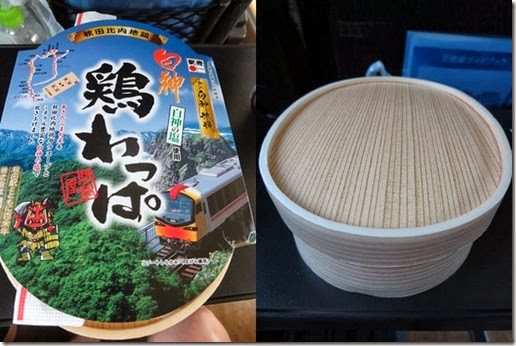
The content was “seasoned rice” with a specific local chicken from the Akita area called “Hinai” ji-dori. 比内地鶏.
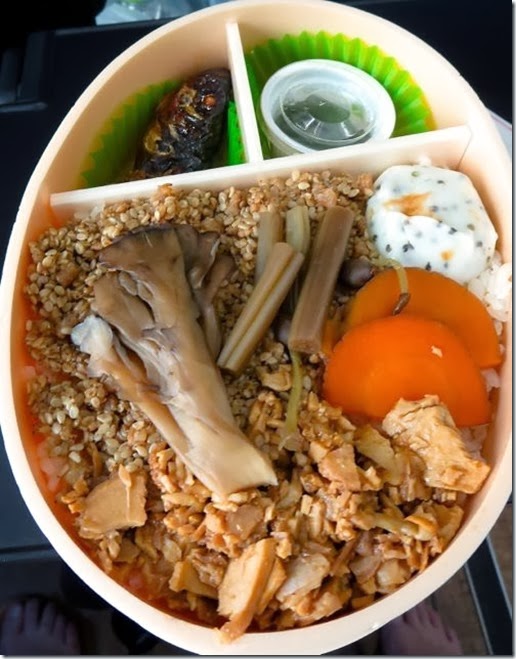
The last bento boxes shown below were ones that we had while riding the train from Hakodate 函館 to Sapporo 札幌. Our train from Aomori 青森 to Hakodate was delayed for no apparent reason (very unusual for Japanese trains) and the train from Hakodate to Sapporo actually had to wait for the connecting passengers (Us!). Although we usually have time to buy Eki-ben at Hakodate station (my wife really likes their “ikura-uni” bento), we had just enough time to transfer from one train to the other at a dead run dragging our luggage behind us--so shopping for bentos was out of the question. (That was the first time we almost missed a connection in Japan due to delays). So we had to get bento on the train.
We knew from past experience that we could make a reservation from the train for a “Kanimeshi-bento” かにめし弁当 or "crab rice bento" from Oshiamanbe 長万部 station. This is a rather famous bento and we wanted to try it. The idea is to make a reservation while the train is heading to Oshiamanbe station. The reserved bento boxes are made just in time to meet the train when it stops.
During this train ride we were attended by a very pleasant lady concierge. (Even though she had the responsibility of checking tickets she still had to serve tea.) She brought us a cold drink and paper slippers as soon as we boarded. She then took orders for lunch including the reservation of “Kanimeshi”. As the train left Oshamanbe station she delivered the bentos to our seats; Americans just don’t know the meaning of service until they’ve experienced it in Japan.
In any case, we had this famous crab rice bento (below). It was a bit disappointing. After all the hype we were expecting a luscious box with big chunks of crab. Instead, the crab meat was very finely ground and dry. It was seasoned sort of sweet and salty. The rice was still warm indicating that it had just been packed but this was not worth the effort and the price. The meat had very little crab flavor; it could have been any dry tasteless fish meat. It was certainly not the best bento we had on the trip—the other bento box we got along with the crab box was much better.
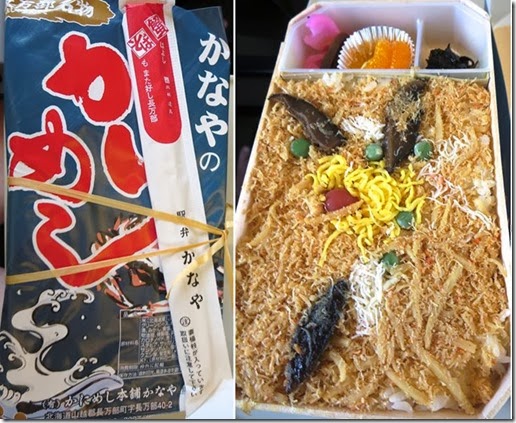
We also got an ekiben which was apparently originated in Hakodate station (below) called “San-kai iro-iro gohan” 山海いろいろごはん meaning “Items from mountains and the sea rice bento”
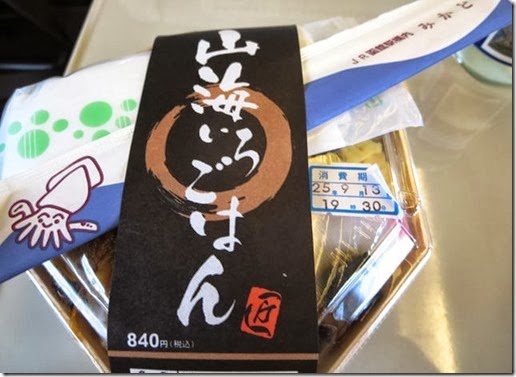
As you can see, items from mountains (small bamboo shoot, shiitake, “fuki”) and from the sea (scallop, salmon roe, kelp roll, fish cake) and other items topped the seasoned rice. For us, this was much better choice.

We knew that the JR Hokkaido and Hakodate line 函館本線 had been plagued with problems. During our ride to Sapporo 札幌, we were concerned about the way the train frequently lurched violently from side to side. My wife actually turned to me and said, “ If this doesn’t let up we could de-rail.” Two days later there was a derailment of a freight train on the same line (no one was hurt). The Hokodate line was closed for several days. My wife’s prognosis apparently was correct. We feel we were lucky. We hope things improve for JR Hokkaido.
One kind of bento which is rather universal either at the train station or the basement floor of department stores (“Depa-chika” デパ地下) called “Makunouchi Bento” 幕の内弁当 which originated from a bento boxes served at the Kabuki theater between performances. Now, among the bento boxes sold at train stations, makunouchi bento is very common and popular. It is offered at different prices and sizes but, essentially, it consists of many small compartments that include cooked fish, meat, vegetables, and rice.

This is the one we had while riding the shikansen 新幹線 train from Tokyo 東京 to Kyoto 京都. This was one of the small makunouchi. The left side is molded rice which is very common in makunouchi which makes picking up rice with chopsticks easy.

Below is an example of a much larger makunouchi bento which we had when we were riding from Kyoto to Tokyo. There are many more compartments than the previous example and the rice in different preparations was in five of the compartments including Inari いなり寿司 (left middle compartment).

 Of course, train riding is thirsty work so some libation goes well with bento. I was a bit disappointed that many kiosks carried different kinds of beer, shochu cocktails, or whisky but sake was either not available or the selection was very limited. Obviously the preference of Japanese people has changed.
Of course, train riding is thirsty work so some libation goes well with bento. I was a bit disappointed that many kiosks carried different kinds of beer, shochu cocktails, or whisky but sake was either not available or the selection was very limited. Obviously the preference of Japanese people has changed.At a kiosk on the shinkansen platform in Tokyo, however, I found some fairly good sake (left) from Nada 灘 (near Kobe 神戸). We think the ultimate is riding a train in comfortable seats, watching the scenery go by, while tasting so many different food items from the bento box and sipping good sake. (one of the reasons we don’t ride the nozomi, even if we could using our Japan rail pass, is because the scenery flashes by so fast we cant watch it without getting dizzy.) The only problem is that the train rides seem to end too soon.
To fix this problem, we rode a scenic well-appointed tourist train which runs from Akita 秋田 to either Hirosaki 弘前 or Aomori 青森 via a local track called "Gonou-sen" 五能線 along the beautiful coast line facing the Sea of Japan north of Akita called “Resort Shirakami” リゾート白神. While the same trip (between Akita and Hirosaki using Oou line 奥羽本線) can be made by conventional train in 2 hours, this tourist train took over 5 hours from Akita to Hirosaki,
The below was the bento we had during the ride. This came in an imitation “Wappa” わっぱ bento box which, in original form, is made of thin Japanese cedar bent into the shape of a bento box. Of course, this was made of plastic (below right).

The content was “seasoned rice” with a specific local chicken from the Akita area called “Hinai” ji-dori. 比内地鶏.

The last bento boxes shown below were ones that we had while riding the train from Hakodate 函館 to Sapporo 札幌. Our train from Aomori 青森 to Hakodate was delayed for no apparent reason (very unusual for Japanese trains) and the train from Hakodate to Sapporo actually had to wait for the connecting passengers (Us!). Although we usually have time to buy Eki-ben at Hakodate station (my wife really likes their “ikura-uni” bento), we had just enough time to transfer from one train to the other at a dead run dragging our luggage behind us--so shopping for bentos was out of the question. (That was the first time we almost missed a connection in Japan due to delays). So we had to get bento on the train.
We knew from past experience that we could make a reservation from the train for a “Kanimeshi-bento” かにめし弁当 or "crab rice bento" from Oshiamanbe 長万部 station. This is a rather famous bento and we wanted to try it. The idea is to make a reservation while the train is heading to Oshiamanbe station. The reserved bento boxes are made just in time to meet the train when it stops.
During this train ride we were attended by a very pleasant lady concierge. (Even though she had the responsibility of checking tickets she still had to serve tea.) She brought us a cold drink and paper slippers as soon as we boarded. She then took orders for lunch including the reservation of “Kanimeshi”. As the train left Oshamanbe station she delivered the bentos to our seats; Americans just don’t know the meaning of service until they’ve experienced it in Japan.
In any case, we had this famous crab rice bento (below). It was a bit disappointing. After all the hype we were expecting a luscious box with big chunks of crab. Instead, the crab meat was very finely ground and dry. It was seasoned sort of sweet and salty. The rice was still warm indicating that it had just been packed but this was not worth the effort and the price. The meat had very little crab flavor; it could have been any dry tasteless fish meat. It was certainly not the best bento we had on the trip—the other bento box we got along with the crab box was much better.

We also got an ekiben which was apparently originated in Hakodate station (below) called “San-kai iro-iro gohan” 山海いろいろごはん meaning “Items from mountains and the sea rice bento”

As you can see, items from mountains (small bamboo shoot, shiitake, “fuki”) and from the sea (scallop, salmon roe, kelp roll, fish cake) and other items topped the seasoned rice. For us, this was much better choice.

We knew that the JR Hokkaido and Hakodate line 函館本線 had been plagued with problems. During our ride to Sapporo 札幌, we were concerned about the way the train frequently lurched violently from side to side. My wife actually turned to me and said, “ If this doesn’t let up we could de-rail.” Two days later there was a derailment of a freight train on the same line (no one was hurt). The Hokodate line was closed for several days. My wife’s prognosis apparently was correct. We feel we were lucky. We hope things improve for JR Hokkaido.
Subscribe to:
Posts (Atom)






